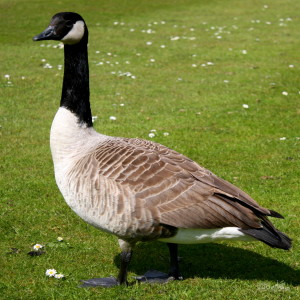 The male Canada goose weighs between 5.7 to 14.3 lbs; and the
female is slightly lighter ranging from 5.3 to 12.1 lbs. The black head
and neck with a white chinstrap are recognizable characteristics of
the Canada goose. Of all the sub-species of geese, the Canada
goose is on average the largest. They breed in both Canada and
northern United States; and, a large portion of the population resides
in the Great Lakes region. Overhunting and a loss of habitat in the
late 19th century and early 20th century resulted in a serious decline.
However, with improved game laws and federal, state and and
private programs, the population increased in their major habitat ranges.
Canada geese are primarily herbivores though they will sometimes eat small insects and fish. During migration, Canada geese have resting areas where they join with others.
The male Canada goose weighs between 5.7 to 14.3 lbs; and the
female is slightly lighter ranging from 5.3 to 12.1 lbs. The black head
and neck with a white chinstrap are recognizable characteristics of
the Canada goose. Of all the sub-species of geese, the Canada
goose is on average the largest. They breed in both Canada and
northern United States; and, a large portion of the population resides
in the Great Lakes region. Overhunting and a loss of habitat in the
late 19th century and early 20th century resulted in a serious decline.
However, with improved game laws and federal, state and and
private programs, the population increased in their major habitat ranges.
Canada geese are primarily herbivores though they will sometimes eat small insects and fish. During migration, Canada geese have resting areas where they join with others.
Location: Animals Formerly at Zoo
Share:
Range
Besides Ohio and the Great lakes, large populations of Canada geese have taken up permanent residence in Esquimalt, British Columbia as well as the Lower Mainland. Large flocks can also be found in Chesapeake Bay, Virginia, North Carolina, and the San Francisco Bay area.
Habitat
Canada geese are frequently seen year-round at urban environments such as golf course, public parks and beaches due to their abundance of man-made bodies of water that are near food sources.
Conservation Status
Least Concern
Primary Threats
Gestation
With the male remaining nearby, the incubation period for the female lasts for 24–32 days after
laying. Canada Geese can adjust their laying data in response to external climate factors.
Litter
Between 2-9 eggs, with the average being 5
Behavior
Canada geese will attack if they feel their goslings are threatened. They will stand erect, spread their wings and make a hissing sound after which they often charge whoever is threatening them. Calls can be heard overhead from large groups of geese flying in a V-shaped formation as they transition in their migration during spring and autumn.
Reproduction
Geese look for a mate in the second year of their lives and remain monogamous unless one dies.
Offspring fledge any time between 6 to 9 weeks of age. Adults molt in the summer between 20-40 days.
Wild Diet
Green vegetation, grains and grasses.
Zoo Diet

